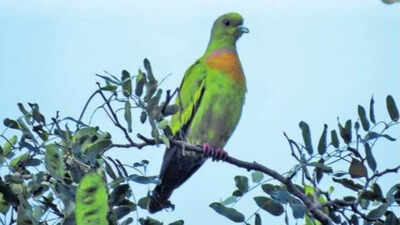- News
- City News
- salem News
- Salem forest host to a high flying pigeon and a butterfly
Trending
This story is from January 26, 2022
Salem forest host to a high flying pigeon and a butterfly
Among the droves of migratory birds and kaleidoscope of butterflies in Salem’s forests two new visitors were spotted during the census on birds and butterflies — the orange breasted green pigeon and Indian cabbage white butterfly.

The high altitude orange breasted green pigeon and Indian cabbage white butterfly were spotted in the Salem forest region
SALEM: Among the droves of migratory birds and kaleidoscope of butterflies in Salem’s forests two new visitors were spotted during the census on birds and butterflies — the orange breasted green pigeon and Indian cabbage white butterfly.
Both higher altitude inhabitants, were a surprise find for the experts who were part of the census between December 17 and 19, 2021, across the Salem forest division. “The orange breasted green pigeon is usually found in the south of the Himalayas and across parts of the Indian subcontinent and southeast Asia,” said K Gautam, district forest officer (DFO), Salem forest division.These birds are found in pairs or in small flocks, fly swiftly and hardly make stopovers. “These birds have sharp flick in their wings due to which they fly very fast,” he said.
Ornithological experts say these birds are commonly found in large numbers in lower Himalayas and in the south mainly in the Western and Eastern Ghats. “These birds are found in Sri Lankan forests. We suspect these birds may have come from Sri Lankan forests,” said an ornithologist, who was part of the team.
The officials found 147 varieties of butterflies in the forest, among which the Indian cabbage white butterfly that has been known to live at an altitude of nearly 2,000 mean sea level was found for the first time in the Salem forest. “This butterfly is usually found in Himalayan region, China, Nepal, Indonesia, Pakistan, Myanmar, Sikkim and Bhutan,” the DFO said. plant, these butterflies lay eggs on it and have been named after the vegetable. “The farming community will confor their crops, but this butterfly does not cause any damage to the plant.
The experts also found 225 varieties of birds and of them 175 were from Salem based, 49 from other states, districts and countries. During the drive, the officials also found 147 varieties of butterflies.
The team of officials including 40 forest personnel and 83 experts split into 16 teams and carried out the drive across 1,24,763 hectares of forest. “We will take this census report to our higher officials for further studies,” said Gautam.
Email your feedback with name and address to southpole. toi@timesgroup. com
Both higher altitude inhabitants, were a surprise find for the experts who were part of the census between December 17 and 19, 2021, across the Salem forest division. “The orange breasted green pigeon is usually found in the south of the Himalayas and across parts of the Indian subcontinent and southeast Asia,” said K Gautam, district forest officer (DFO), Salem forest division.These birds are found in pairs or in small flocks, fly swiftly and hardly make stopovers. “These birds have sharp flick in their wings due to which they fly very fast,” he said.
Ornithological experts say these birds are commonly found in large numbers in lower Himalayas and in the south mainly in the Western and Eastern Ghats. “These birds are found in Sri Lankan forests. We suspect these birds may have come from Sri Lankan forests,” said an ornithologist, who was part of the team.
The officials found 147 varieties of butterflies in the forest, among which the Indian cabbage white butterfly that has been known to live at an altitude of nearly 2,000 mean sea level was found for the first time in the Salem forest. “This butterfly is usually found in Himalayan region, China, Nepal, Indonesia, Pakistan, Myanmar, Sikkim and Bhutan,” the DFO said. plant, these butterflies lay eggs on it and have been named after the vegetable. “The farming community will confor their crops, but this butterfly does not cause any damage to the plant.
white larvae small brassaid, adding that large infestations can often defoliate whole brassica crops if left untreated.
The experts also found 225 varieties of birds and of them 175 were from Salem based, 49 from other states, districts and countries. During the drive, the officials also found 147 varieties of butterflies.
The team of officials including 40 forest personnel and 83 experts split into 16 teams and carried out the drive across 1,24,763 hectares of forest. “We will take this census report to our higher officials for further studies,” said Gautam.
Email your feedback with name and address to southpole. toi@timesgroup. com
End of Article
FOLLOW US ON SOCIAL MEDIA










